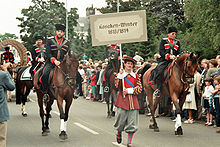Cossack winter
Cossack winter describes the billeting of Danish , Swedish and Russian troops in Schleswig-Holstein in the winter of 1813/1814. The Cossacks of the Russian troops made up the smallest part of the troops, but left the greatest impression on the population.
After France's lost war against Russia (1812), Napoleon's opponents - Prussia , Austria , Sweden , Russia and Great Britain - formed an alliance against Napoleon. Denmark continued to support France. After the Battle of the Nations near Leipzig (October 16-19, 1813), a Swedish-Russian-Prussian army with 57,000 men under the Swedish Crown Prince Karl Johann - the former French Marshal Jean-Baptiste Bernadotte - advanced into Schleswig-Holstein and defeated the Danish Troops who were able to retreat to the protective fortress Rendsburg .
Cossack winter in Ostholstein
Even after the peace treaty in Kiel (January 14, 1814), the foreign troops remained in Holstein . The area was spared billeting until July 1814. In a letter dated July 12, 1814, the commission for the repossession of the duchies informed the magistrate of the city of Oldenburg that the army under the general en chef Graf von Bennigsen would further the demarcation line to the east in order to facilitate the areas of the duchy of Holstein previously affected by billeting wanted to move.
The headquarters of the Perejaslav cavalry regiment was relocated to Lensahn . The individual units were quartered in Beschendorf , Cismar , Damlos , Gosdorf , Güldenstein , Halendorf , Harmsdorf , Kabelhorst , Koselau , Langenhagen , Manhagen , Marxdorf , Mönchneversdorf , Nienrade , Petersdorf , Quaal , Rethwisch , Riepsdorf , Rüting , Schwienkuhl , Sievershagen and Wahrendorf .
The population suffered greatly from the high costs of billeting:
- Rumors have been going for four weeks that the Russians are marching out. You are still there. They suck the hoof-tenants too much, sometimes with their forage they steal from the farmers, and it becomes difficult for them to feed. What is used up for light and wood! May they leave us soon.
In December 1814, the troops withdrew and left a drained land. In an overview drawn up in 1821, Friedrich Börm reports on the burdens on the Fideikommissgüter:
- ... calculated for one day 4083 officers and 96504 non-commissioned officers and commons, all of them cavalry, in the ducal estates. ... delivered in kind: 37,511 pounds of bread, 8,830 pounds of bacon, 8,314 pounds of pearl barley, 1,264 pounds of peas, 1009 tons of oats, 115,983 pounds of hay and 29,235 pounds of straw.
In 1817 the Danish state reimbursed part of the expenditure.
Cossack winter in the Pinneberg rule
During the siege of Hamburg in the winter of 1813/14, the headquarters of the Russian troops under General Bennigsen was in Pinneberg .
The Uetersen population suffered particularly from the billeting of the troops of Colonel d'Olonne, General von Pahlen and General von Voronzow . Almost every day foreign troops marched through the city along the old military road . Foreign troops were quartered in all private houses and public buildings and had to be fed. There was looting , arson and attacks on the population. During this time around 48,000 soldiers with around 28,800 horses were camped in or pulled through the town. The costs for the city and the monastery were enormous. The total cost of damage, raids and extortion in the city amounted to around 20,000 thalers . In addition, there were the costs for billeting and feeding the troops and horses. The subsistence costs for Colonel d'Olonne and Lieutenant General Voronzow alone amounted to around 2,160 thalers. They asked for a free table for themselves and their 30 to 40 officers every day. The hospital for the sick and wounded cost the monastery 11,000 thalers. After the troops had withdrawn, the monastery received remuneration in Bons (Russian debt). The population, however, was not compensated.
literature
- Lothar Mosler : Uetersen, history and stories 1234–1984 (Kosakenwinter 1813/14 - The Russians are coming)
- Dieter Kienitz: The Cossack winter in Schleswig-Holstein 1813/14. Boyens, Heide 2000, ISBN 3-8042-0865-7 .
- Eva S. Fiebig: The Kosakenwinter - The occupation of the duchies by the Northern Army 1813/14 , in: Der Kieler Frieden 1814, ed. by Sonja Kinzler, Neumünster / Hamburg 2013, pp. 58–73.
See also
Individual evidence
- ↑ Dieter Kienitz: Der Kosakenwinter , p. 63

